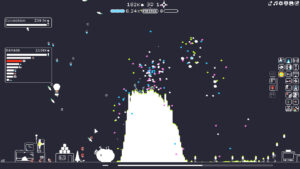(the) Gnorp Apologue
 As usual, I picked up a bunch of cheap stuff in the still-ongoing seasonal Steam sale. Mostly things that are pretty cheap normally, but which I nonetheless just threw on my wishlist until their cheapness hit “sure, why not” level. And of these things, the one I’ve found the most interesting is (the) Gnorp Apologue.
As usual, I picked up a bunch of cheap stuff in the still-ongoing seasonal Steam sale. Mostly things that are pretty cheap normally, but which I nonetheless just threw on my wishlist until their cheapness hit “sure, why not” level. And of these things, the one I’ve found the most interesting is (the) Gnorp Apologue.
It’s basically an idle game, albeit one of the smaller-scale ones, with a win condition that you can reach in a single day if you try. The focus of the game is a big rock, which flakes off shards when clicked or otherwise attacked. These shards are greatly prized by the Gnorps, boxy little dudes who use them as currency. So you spend the shards on housing for Gnorps, which you assign to tasks such as assaulting the rock or gathering the resulting shards, or on other buildings or upgrades that help the process somehow. Every once in a while, you decide that things aren’t advancing fast enough and end the run, trading in your progress for “talent points” that can be spent on more powerful strategic upgrades. That much is pretty much standard for the genre. It’s worth noting that (t)GA varies the formula a bit by making the talent points reassignable per run, letting you experiment with different builds — some of the talents synergize, others work against each other. But that’s a fairly minor innovation, and one that I wouldn’t be surprised to see independently invented by other games in the genre.
The thing that really makes it stand out is the presentation. Idle games tend to be fairly abstract, putting everything into text and numbers (and letting those numbers reach unimaginable heights). In (t)GA, everything you build, every Gnorp you hire, each bullet and arrow and missile fired at that big rock, is concrete, visible on a big scrolling playfield, busily going this way and that. By the end, you’ll probably have hundreds of rockets flying around all the time, and you can see every single one in the sky. Uncollected shards mound up, forming a pile that, absurdly enough, quickly towers over the rock they came from. It’s not just illustration, either; things visibly happen as a result of the movement of Gnorps and other objects through physical space, and the order in which you build things can affect where they’re placed and, consequently, how efficiently they operate. We’re used to this level of animation in sims and strategy games, but in an idle game, it’s amusingly novel.
 Comments(0)
Comments(0)